Productising the bidding process to increase the number of daily vehicles for sale
Product Designer | B2B | Web | 2020
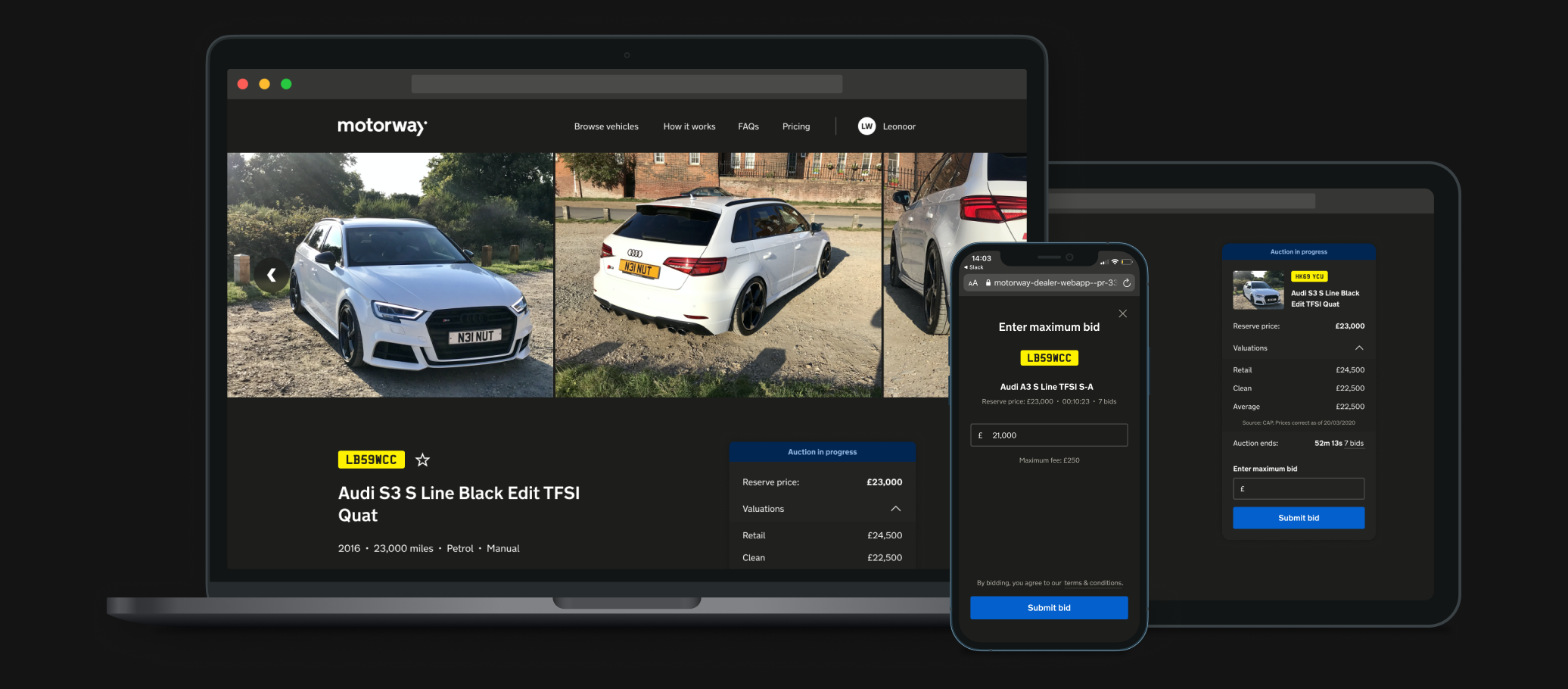
Overview
Believe it or not, until June 2020, Motorway did not have a way to bid online. All bidding was conducted by dealers reviewing the vehicle they want to buy, and calling up the motorway team to place their bid to the right Account manager. This meant that we could only manage to put around 50 vehicles into a daily sale.
Goal: Productise the bidding process, creating a fully online sealed bidding platform to connect dealers and agents instantly.
Role
Product Designer
Usability testing, QA, UX/UI , motion design, competitor analysis.
Teammembers
1 x Product Manager, 2 x Frontend developers 1 x Backend developer
Timescale
March 2020 - June 2020
The challenge
Dealers could not easily bid on vehicles that they see within the Motorway Pro site. This causes a huge interruption to their day, which in turn would severely impact the number of sales Motorway would make.
Agents cannot handle the volume in which we can receive, process, and respond to bids. This means we cannot sell the volume of vehicles that we wanted to sell, delaying the length of a sale time for sellers, and creating a process which heavy friction points for dealers. As a business we decided to address this as a high priority to ensure as we grew the business we could withstand the anticipated influx with our roadmap ahead of us.
This was pivotal for the business, as we had began working on it just as the first COVID lockdown happened, and all dealer trading had been instructed by the government to stop. We needed to create this online bidding structure in time for the relaxation of the rules allowed dealers to begin trading again, as all physical car auctions were still not allowed, and therefore we knew that we could sell vehicles well before the majority of our competitors were able to.
The Solution
The discovery phase for this was extensive, as it was vital we ensure the user experience to be right, as a poorly thought out experience for high intent dealers could be detrimental to the business. We needed to correctly map out the various different journeys the dealer could take when bidding on a vehicle, and depending on the price if it was well above, reserve or below reserve, what the next steps could be for them, but also if they need to cancel or have incorrectly placed a bid.
Theres also another large scenario of what if a vehicle doesn’t actually get a bid, which then puts the vehicle into a buy it now state. This opens the option up for the dealers to place an offer on a vehicle to buy it then and there, avoiding a further auction.

One of the basic user flows for the online bidding process, ironing out edge cases as well as the happy path.
A large focus within this project was reimagining the vehicle details page, to showcase the price of the vehicle with the opportunity to bid at any time during their browsing experience. As dealers view this page everyday for their business, it can be a highly emotive area within the product to alter, and therefore we approached many dealers with our solution to understand how they would interact with it, and the information we were displaying to them.
We wanted to ensure that dealers know we are giving them a considered and well thought through price without them having to confirm this using external sites, for example we showcase not just the price, but also CAP, retail and clean, so that they can bid with complete confidence. Though we had the concern of how much information is too much information? If we showcase the total breakdown of the sale, will that deter dealers? If they see the Motorway fee just as they bid, will this create disruption to the bidding process? Motorway fees are based off the price of the vehicle, and therefore our concern was showing it very up front could possibly open up the platform to playing the system.
All of the pricing information we needed to make sure was shown to agents, but still sealing the bids during the auction hours to try to irradicate the dealers who would play the system trying to get the winning bid, improving the way that we worked at that point which was that one account manager would work with a set of dealers, having to input their bids into the system.
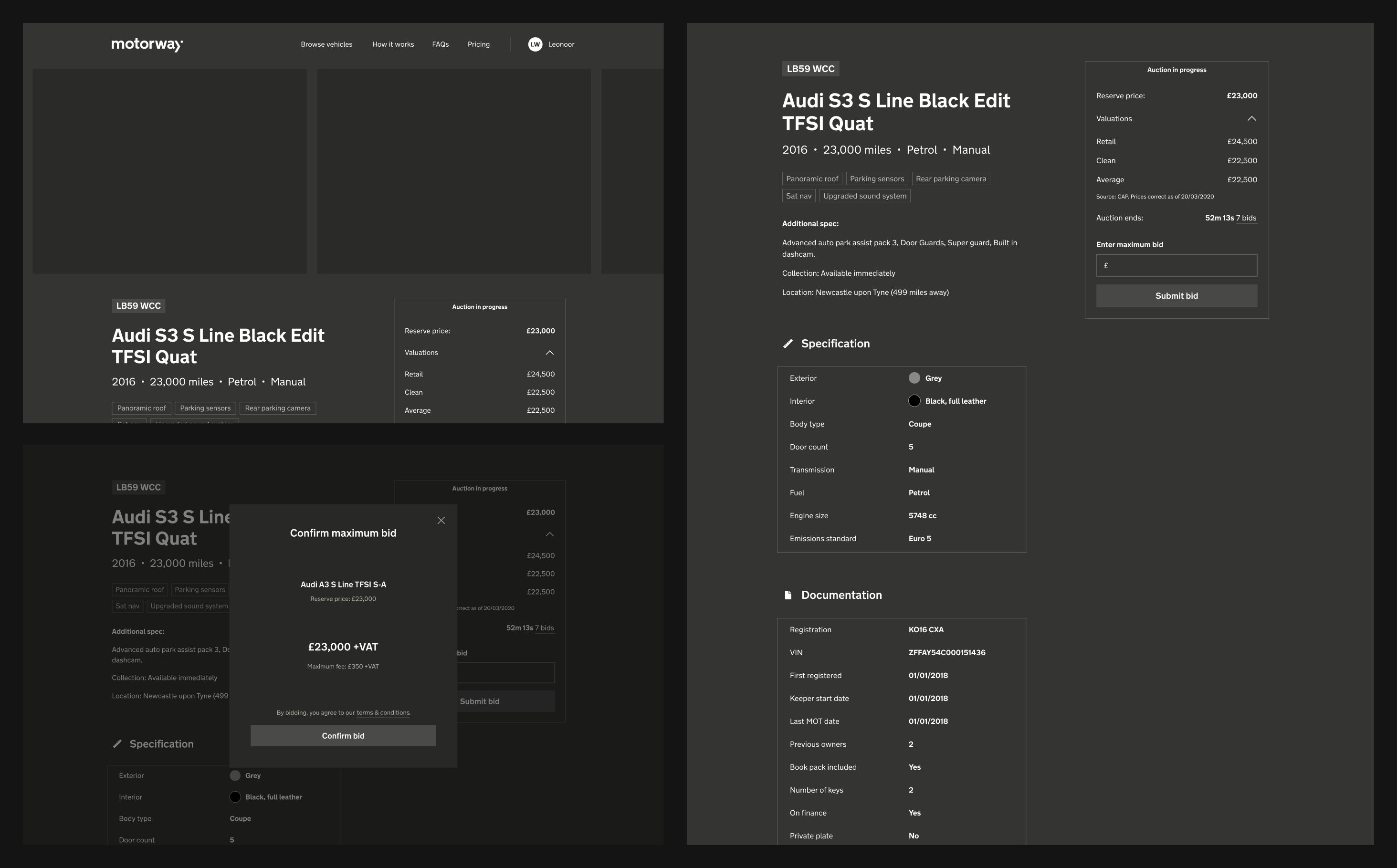
A few shots of the mid-fi wireframes created, that were used for testing with dealers within a prototype.
When getting to the smaller details of this product, I wanted to make sure that dealers were still able to have a great experience on mobile. At this point the Pro platform was 80% desktop so it was not as high a priority to make sure that smaller breakpoints were seamless, however we anticipated that after COVID dealer habits were to change, and we wanted to be prepared for anything.
The online bidding feature required a step to enter their price, and another to confirm the price whilst they understood the price breakdown. Our customer mobile device breakdown was incredibly varied and therefore I wanted to make sure that no matter the size they were still able to bid seamlessly. This meant I had to take into account the browser navbars, the keyboard height and accommodate for increased text size for those who have manually changed their device settings. including the various vehicle information, as well as the input field and CTA was accomplished by displaying progressive information when appropriate. We wanted to make sure that the input and CTA would always be accessible (don’t you hate it when you have to close a keyboard in order to press the CTA?).
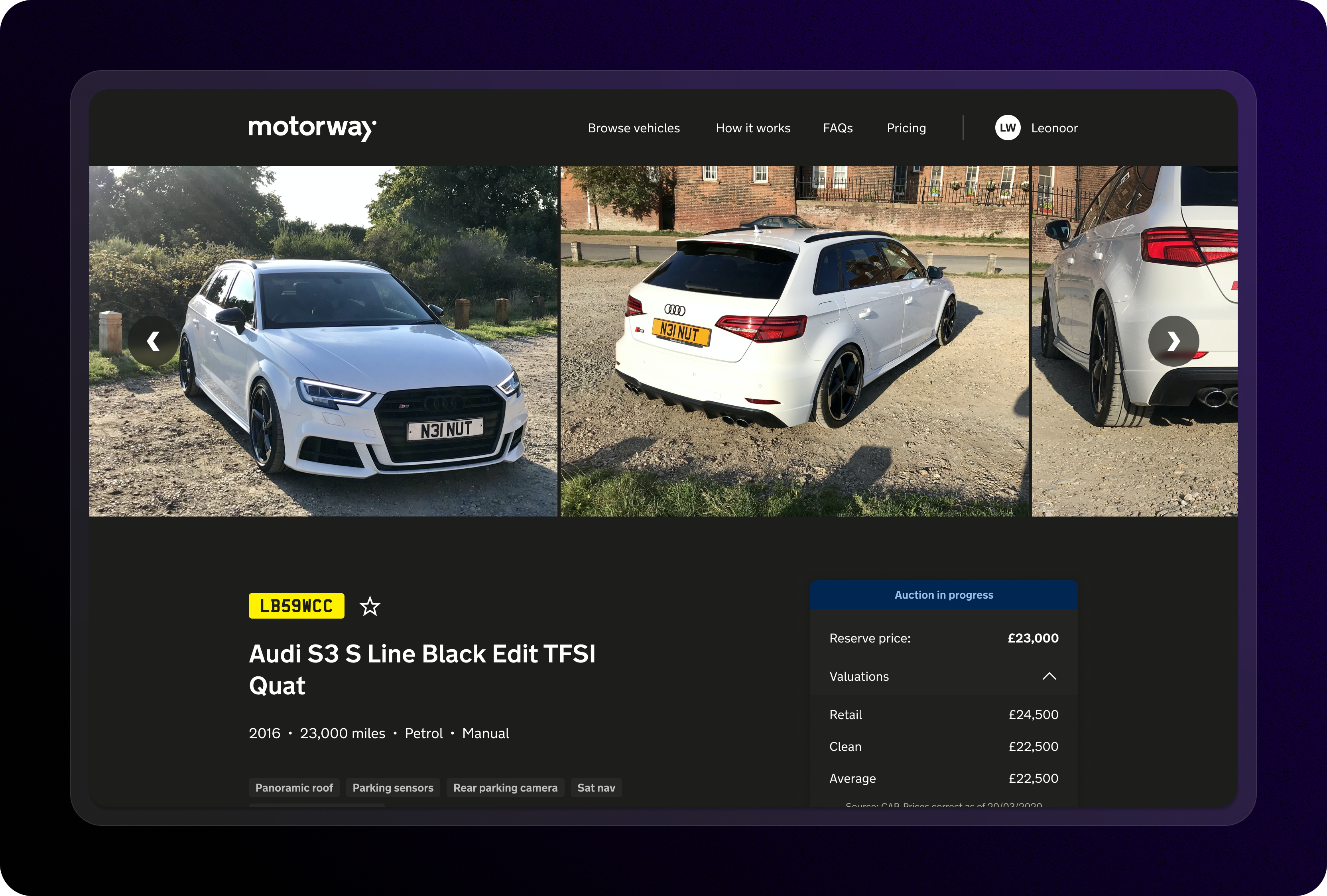
A shot of the vehicle details page, which has mainly remained the same since my redesign. The dealer is able to at a glance see the details as well as the pricing for the vehicle, as soon as they land on the page.
A large focus within this project was reimagining the vehicle details page, to showcase the price of the vehicle with the opportunity to bid at any time during their browsing experience. As dealers view this page everyday for their business, it can be a highly emotive area within the product to alter, and therefore we approached many dealers with our solution to understand how they would interact with it, and the information we were displaying to them.
We wanted to ensure that dealers know we are giving them a considered and well thought through price without them having to confirm this using external sites, for example we showcase not just the price, but also CAP, retail and clean, so that they can bid with complete confidence. Though we had the concern of how much information is too much information? If we showcase the total breakdown of the sale, will that deter dealers? If they see the Motorway fee just as they bid, will this create disruption to the bidding process? Motorway fees are based off the price of the vehicle, and therefore our concern was showing it very up front could possibly open up the platform to playing the system.
All of the pricing information we needed to make sure was shown to agents, but still sealing the bids during the auction hours to try to irradicate the dealers who would play the system trying to get the winning bid, improving the way that we worked at that point which was that one account manager would work with a set of dealers, having to input their bids into the system.
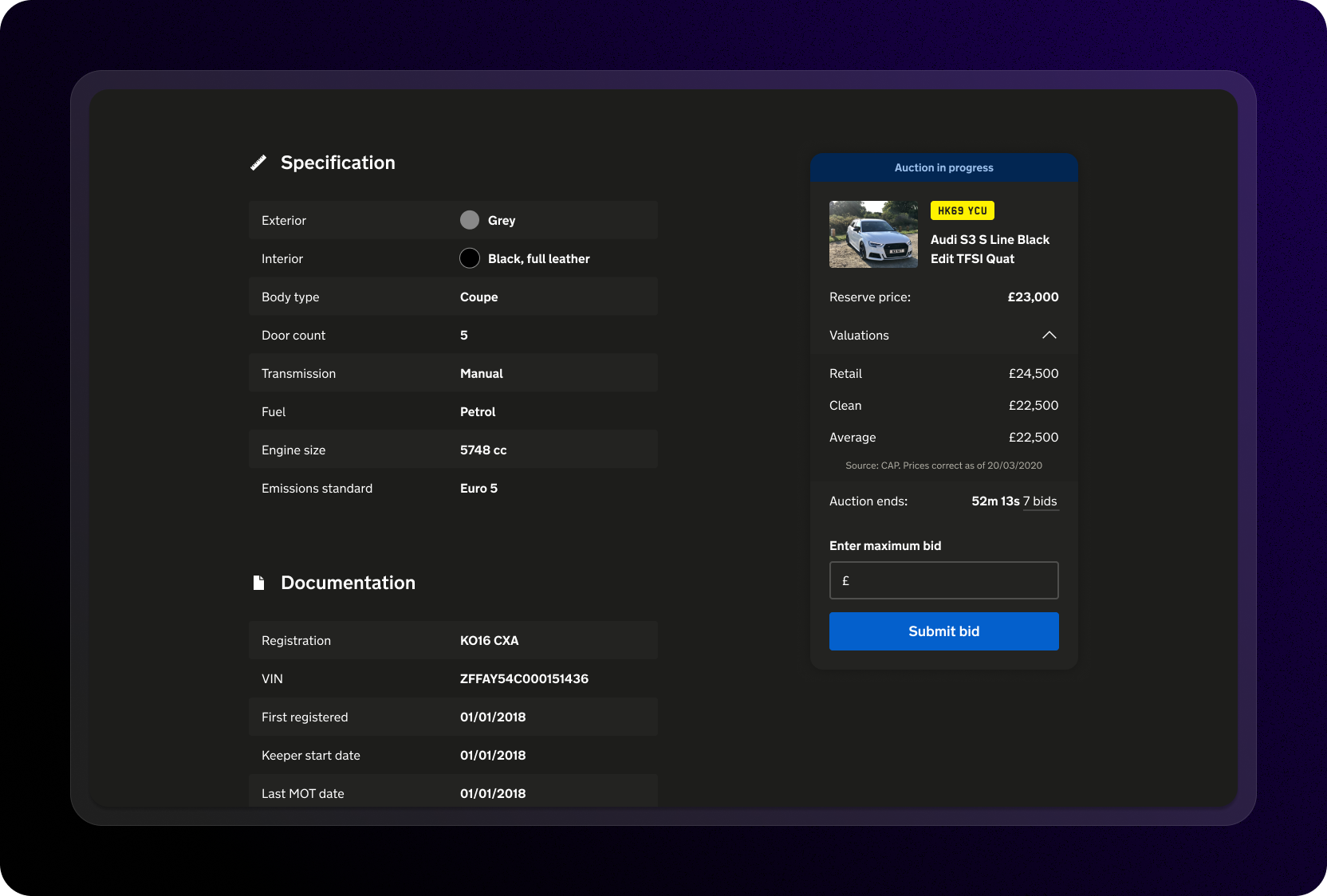
Once scrolled past the initial details, the sidebar animated so the dealer can still see the information, all of the most important information on the right hand side.
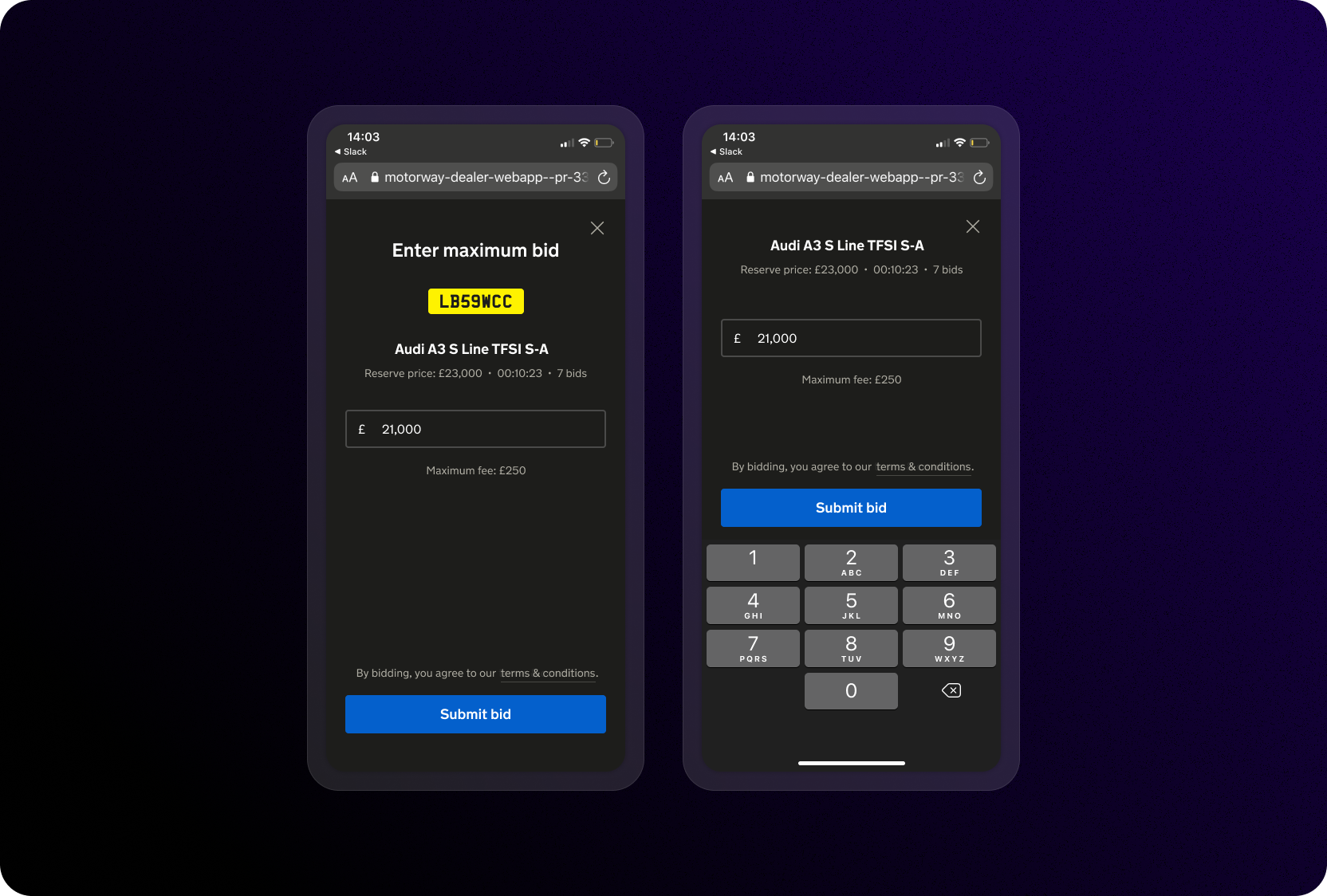
Using native features and the Motorway design system, we created the modal that would auto adjust depending on the height of the device.
Results & metrics
This was a complete game-changer for the business. As much as I would love to say that we had completely altered the trajectory of Motorway due to my product design input, it was far far more than that. We were able to release online bidding to our userbase the day that the lockdown had lifted, much to the delight of our dealers who have been unable to work for that entire few months. There was still a ban on in person auctions, which meant that majority of our competitors were unable to trade, so we had an influx of dealers arriving to our platform to bid on cars. We were able to handle this rapid increase because of the online bidding feature, and even increasing dealer retention.